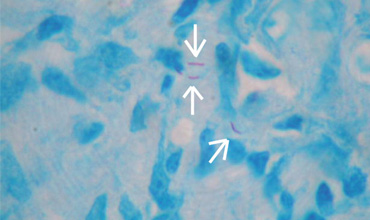The Effectiveness of Acid Fast Bacilli (Afb) Smear Microscopy Training in Performance Improvement Among Nigerian Military Hospital TB Laboratory Personnel: Analysis of Pre and Post Training Evaluation Scores

Abstract:
OBJECTIVE
This
study is planned to determine the effectiveness of AFB smears microscopy
training and refresher training on the performance of TB laboratory personnel
working in the Nigerian Military Hospital.
BACKGROUND
With an
estimated 9.4 million new cases globally, tuberculosis (TB) continues to be a
major public health concern1. Eighty percent of all cases worldwide
occur in 22 high-burdens, mainly resource-poor settings of which Nigeria ranked
13th. This devastating impact of tuberculosis on vulnerable populations is also
driven by its deadly synergy with HIV. Therefore, building capacity and
enhancing universal access to rapid and accurate laboratory diagnostics are
necessary to control TB and HIV-TB co-infections in resource-limited countries2.
In low income countries (Nigeria inclusive), Ziehl-Neelsen sputum smear
microscopy is the only cost-effective tool for diagnosis and monitoring of
patients on treatment3. In order to have efficient and reliable AFB
microscopy centres, it is very necessary to have continuous refresher training
for laboratory professionals and strong External Quality Assessment (EQA)
system. However, very little data exists as to the effect of in-service
training on performance of laboratory personnel in Nigeria.
METHODS
A
cross-sectional retrospective study was conducted to appraise theoretical and
practical performance of TB Laboratory personnel drawn from various Nigerian
Military hospitals supported by the joint partnership of Nigerian Ministry of
Defence (NMOD)/United States Department of Defense Walter Reed Program-Nigeria
(USDOD WRPN), before and after AFB microscopy training. Theoretical assessment
was based on standard questions while practical assessment was based on smear
reading of 10 standard slides. Data generated from four (4) rounds of a five
days AFB Smear Microscopy training at NTBLTC, Zaria, Kaduna State, Nigeria
between 2011 and 2013 was retrospectively collated and analyzed using SPSS 16.0
statistical software.
RESULT
The
pre-training mean score of the theoretical knowledge and practical skills were 64.3% and 64.5%,
respectively. The post training
mean scores were 83.6%
and 85.3% for theoretical
knowledge and practical skills, respectively. The increase in mean score of
both theoretical and practical assessment was statistically significant
(p<0.0001). Post training mean score of theoretical knowledge was higher
among diploma holders trainees than the BSc degree counter parts (p=0.001). The
mean scores on practice before and after training were dependent on
participation in previous AFB microscopy trainings (p<0.0001). Proportions
of participants with both major and minor errors were found to decrease after
they were trained. Trainees who have had previous training were found to commit
less error than those who have never participated in previous training
(p<0.0001).
CONCLUSIONS
This
study established that training improved theoretical and practical
performance of Medical Laboratory personnel. Training and continuous training
irrespective of lab professional’s qualification, service status and service
year and sustainable EQA are highly recommended to ensure quality of AFB
microscopy services in all NMOD/USDOD supported health facilities across the
country.
References:
1.
Arslan S, Ozdemir L, Demirel Y, Akkurt I: The
validity of diagnostic methods in predicting pulmonary tuberculosis. Afr J
Microbiol Res 2010, 4:613–617.
2.
CJ
Mundy, AD Harries, A Banerjee, FM Salaniponi, CF Gilks, SB Squire. Quality
assessment of sputum transportation, smear preparation and AFB microscopy in a
rural district in Malawi. Int J Tuberc Lung Dis 2002; 6: 47-54.
3.
International Union against Tuberculosis and
Lung Disease: Sputum examination for tuberculosis by direct microscopy in Low
income countries. Technical guide. 5th edition. Paris, France: IUATLD; 2000.
5. Martinez-Guarneros
A, Balandrano-Campos S, Solano-Ceh MA, Gonzalez- Dominguez F, Lipman HB,
Ridderhof JC, Flisser A: Implementation of proficiency testing in conjuction
with a rechecking system for external quality assurance in tuberculosis
laboratories in Mexico. Int J Tuberc Lung Dis 2003, 7:516–521.
6. Rieder
HL, Chonde TM, Myking H, Urbanczik R, Laszlo A, Kim SJ, Deun AV, Trébucq A: The
public health service national tuberculosis reference laboratory and the
national laboratory network: minimum requirements, role and operation in a
Low-income country. Paris, France: International Union Against Tuberculosis and
Lung Disease; 1998. ISBN 2-9504238-7-6.
7. Selvakumar N, Kumar V, Gopi PG, Sivagamasundari S, Prabhakaran E, Vasanthan S, Narayanan PR: Proficiency to read sputum AFB smears by senior tuberculosis laboratory supervisors under training at a reference laboratory in India. Indian J Tuberc 2005, 52:11–14.
8. Van
Rie A, Fitzgerald D, Kabuya G, Van Deun A, Tabala M, Jarret N, Behets F, Bahati
E: Sputum smear microscopy: evaluation of impact of training, microscope
distribution, and use of external quality assessment guidelines for
resource-poor settings. J Clin Microbiol 2008, 46:897–901.
9. World Health Organization (WHO), Association of Public Health Laboratory (APHL), center for Disease Control (CDC), International Union Against Tuberculosis and Lung Disease: External quality assessments for AFB smear microscopy. Washington DC: Association of Public Health Laboratories; 2002.
10.
WHO
October 2013 (GTB number C7): www.who.int/tb/challenges/mdr
11.
WHO
2013; HIV Associated TB Facts; http://www.who.int/tb/challenges/hiv/
12.
WHO
2013; Tuberculosis Diagnostics: www.who.int/tb
13.
WHO
2012; Nigeria Tuberculosis
Profile; www.who.int/tb/data.
14.
World Health Organization: Laboratory services
in tuberculosis control: Organization and management, Part I WHO/TB/98258 1998.
Geneva, Switzerland: WHO; 1998.

